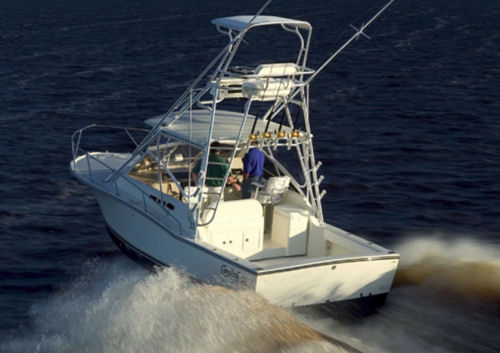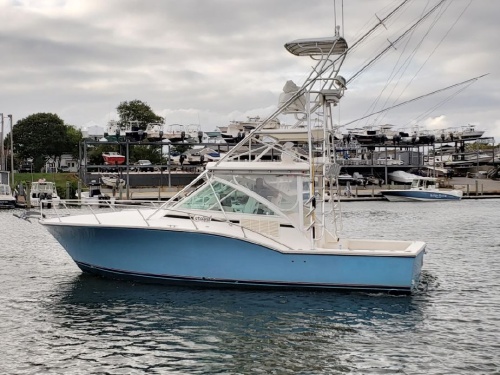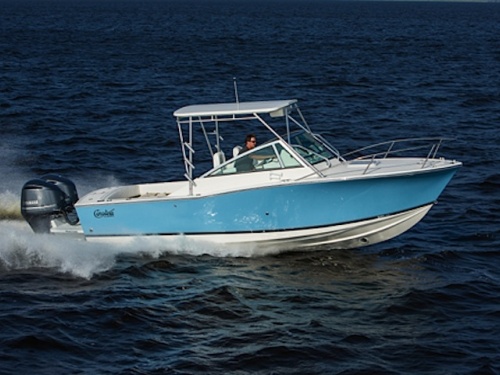Access More Boat Tests
Already have an account? Login
Carolina Classic 28 (2013-)
Brief Summary
The Carolina Classic 28 has long been the David to the gold-plated Goliaths of the offshore sportfishing world. But like the biblical David this boat is not cowed by the big guys and increasingly anglers are beginning to understand the advantages of down-sizing. And when they do, they discover precious few boats without outboard engines on their transoms -- the very place they want to be battling game fish. Likewise, owners of center consoles looking to move up to go farther offshore are looking for range and increased safety without breaking the bank. Let's take a look at the classic Carolina Classic 28.
Key Features
- Fiberglass encapsulated stringer system
- Bonded and mechanically fastened hull, deck and liner
- 3 bilge pumps with indicator lights
- Bilge with mildew-resistant finish
- Vibration-absorbing engine mounts
- Self-bailing cockpit
- Tackle cabinet/seat
- Electric head with holding tank and Y-valve
- Medicine cabinet, sink with counter top, mirror, and pressurized shower
- Windshield with opening vents and wiper
Specifications
| Length Overall | 28' 5'' / 8.66 m |
|---|---|
| Beam |
10' 6'' 3.2 m |
| Dry Weight | N/A |
| Draft |
30'' 0.76 m |
| Deadrise/Transom | 24 deg. |
| Max Headroom | N/A |
| Bridge Clearance | N/A |
| Fuel Capacity |
256 gal. 969 L |
| Water Capacity |
30 gal. 113.56 L |
Engine Options
| Tested Engine |
Currently no test numbers |
|---|---|
| Std. Power |
Not Available |
| Opt. Power |
Various Crusader, Volvo Penta and Yanmar |
Captain's Report
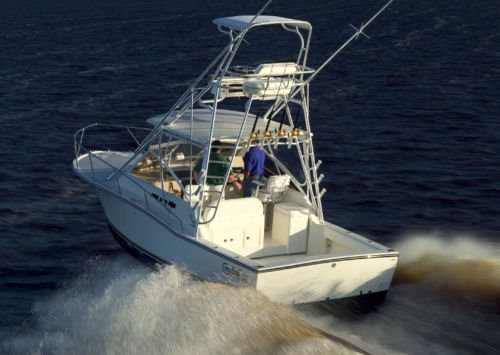
The Mission of the Carolina Classic 28
Carolina Classic’s founders designed the 28 to be a mighty little express fishboat that could run offshore in any weather in relative comfort and have good range – enough to get to the canyons off the New Jersey coast, to say nothing of the Continental Shelf off North Carolina.
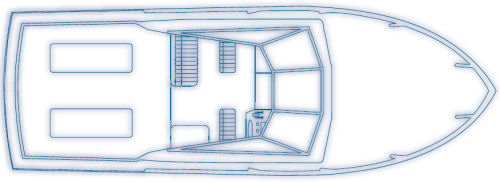
She is intended both for the angler trading down from an expensive sportfisherman or convertible who has grown tired of the maintenance and operating costs of a big vessel that is only used for day fishing. She is also intended for the keen center console owner who wants to venture far offshore for billfish, but who no longer wants to travel into blue water in a boat without a foredeck. Finally, she is dedicated to boaters who want inboard power for reasons of fuel efficiency, safety or simply to clear the transom of engines or lower units that get between the angler and his prey.
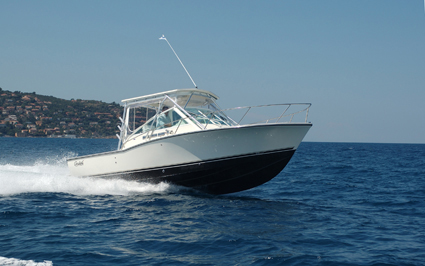
Distinguishing Features
●
Inboard Power Under 30’.
With the demise of several inboard boat builders in the early 1990s because of the 10% luxury tax on new boats, in addition the latest recession, there are only a few boat companies left building inboard express fishboats under 30’. Of the dozen boats in class we studied from production builders only three fishboats were inboards.
●
Clean Transom.
Since most express fishboats in this size range are outboard powered, anglers who want to take large billfish will appreciate bringing a fish to wire in an inboard-powered boat.
●
Sterndrive Propulsion an Option.
Carolina Classic is one of the few companies who will give buyers the option of installing a sterndrive using jackshafts. It draws less water and is more efficient than inboard power, but it weighs more and has many more moving parts.
●
Heaviest Boat in Class.
This is a number that can't be found on the Carolina Classic website; 13,500 lbs. (6,136 kgs.) makes her far and away the heaviest boat in class. The bad news about this is that it makes her a bit harder to push. The good news is that the added weight makes the ride more comfortable offshore, more stable at rest, and the weight combines with her beam make her less rolly when drift fishing.
●
Lower Center of Gravity.
By having the engine iron low in the middle of the boat rather than hanging off the transom, the boat’s center of gravity is lowered and moved forward. This makes the boat more stable in all conditions, something that the person in the half-tower will appreciate as well as the rest of the crew.
●
24-Degree Deadrise Bottom.
At the transom the 28’s deadrise is 24-degrees, the same as high-performance, offshore racing hulls.
●
Better Weight Distribution/Better Ride.
Because the engine weight is in the middle of the boat, when traveling fast in sloppy seas the 24-degree deadrise boat can better tame the waves and give a better, less bouncy ride.
●
Pure Fishing Machine.
Careful observers will have noted that during the last number of years virtually all builders of fishing boats are marketing them as “family cruisers”, spending money on designer fabrics and creature comforts designed to appeal more to landlubbers. Carolina Classic is having none of that. Its boats are made by anglers for anglers.
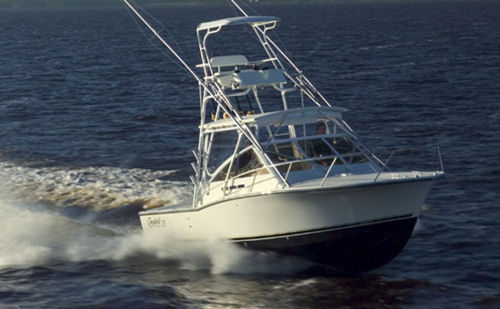
Fishing Country
North Carolina’s Outer Banks is within striking distance of the world-class game fishing to be had off the Continental Shelf where the Gulf Stream meets coldwater eddies from the north creating an ideal habitat for bait fish right up the food chain to giant tuna and record billfish. For generations wealthy anglers from all over the world have come there to have the thrill of a lifetime. In short, that is why North Carolina is the epicenter of fishboat building of all sizes and types.
Carolina Classic Concept
While most Carolina builders started with big boats then ended up building even bigger ones, Carolina Classic has done just the opposite. Founder Mac Privott's vision right from the beginning was to build strong, capable small boats so that more people could afford to do battle offshore along with the white-shoed swells. By building a boat that maxed the size of the cockpit, could handle big seas, and had prodigious range, the 28 could hunt most anywhere for a fraction of what those big Outer Banks boats cost.
Ruggedly Constructed
In our opinion the Carolina Classic 28 is one of the most ruggedly-built boats in class. It is certainly the heaviest at 13,500 lbs. Her bottom is solid fiberglass. Her stringers are robust, her forward cabin is solid and thoroughly glassed to the hull sides to create the kind of structure that can bash through the green stuff offshore. All of this adds weight.
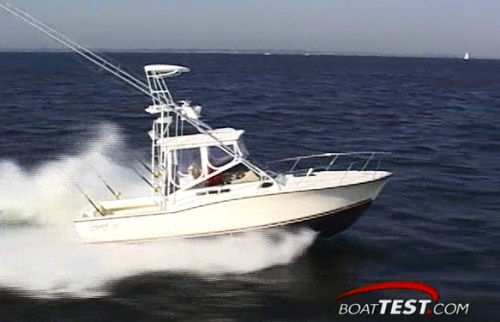
Big Game Ready
1. Cockpit.
It measures nearly 7’10” fore and aft by 10’ wide. That’s about 78 square feet of uncluttered deck space. For those wanting to add a conventional fighting chair with foot rest, there is room.
2. Clean Transom.
No outboard motors in the way. No sterndrive lower units to snag lines. Standard trim tabs are recessed into the hull bottom. Props are under the boat where they belong.
3. Transom Well.
This compartment can be used for several purposes including being an optional large live/bait well. (Big bait for big fish.)
4. Fish Boxes.
There are two fish boxes in the cockpit sole that each measure nearly 5’ x 1.5’ and have a capacity of 160 quart each. These boxes are drained with diaphragm pumps that are more reliable than macerators, according to Keith Privott, vice president of the company. Freezer plates can be added.
5. Scupper Flaps.
Back down and do not worry about water coming through the scuppers.
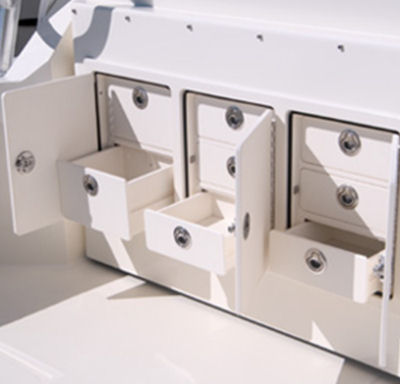
6. Ice Box Cooler.
To starboard there is a top-loading tub that can be used as an ice box rather than storage. On top is a removable cushion. Of course it’s a great place to sit while trolling.
7. Misc. Fishy Stuff.
The Carolina Classic 28 also has virtually all of the smaller fishing details that anglers have come to expect such as racks under the cockpit gunwales for rods, gaffs and nets. To port under the aft-facing bench seat is a cabinet that holds 14 Plano tackle boxes. There are four rod holders in the gunwales, hawse pipes in the stern to run mooring lines, fresh and saltwater wash down bibs, etc.
Optional Fishing Equipment
As different folks will use the boat for different strokes, the builder will do custom work so long as it does not interfere with the basic aspect of the boat. It also makes a number of options available—
1. Live bait well in transom
2. Tuna half-tower with hard top and rocket launchers
3. Long range fuel tankage for diesel
4. Fighting chair with foot rest
5.Coaming pads for cockpit
Engine Room
The engine room of the 28 is under the bridge deck. Push a button and two hydraulic rams tilt the deck, helm, bait prep station, and the cooler up about four feet. Once open, it becomes immediately obvious that things are tight in here, even with the 10'6" beam. Nevertheless, there is enough room for all of the required equipment, including room forward for a generator. The engine options have been selected with care for reliability, vendor customer support, and convenience of fluid checks.
We like the double ram lifting system that is used on the 28 and the unit does lift high enough to give access to the entire engine. Getting to the front of the engines involves some thought, but it can and is done. This is perhaps the biggest compromise on this Giant Killer, but an unavoidable one and certainly better than alternative engine access schemes.
Standard equipment that is noteworthy found in the engine room includes—
●Algae-X fuel system on diesel installations
●Acoustic and thermal insulation
●Automatic fire suppression system
●Auxiliary fuel filter/water separator
●Seawater intake strainers
●Dripless shaft logs
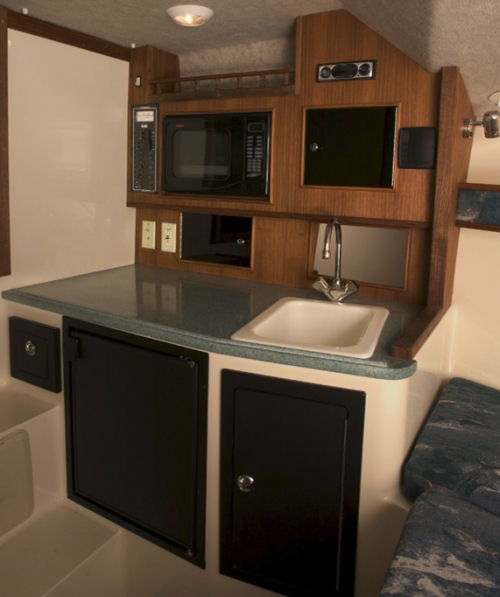
Below Decks
As we implied above, the most important thing about this 28’ fishboat is the fact that it has a fore deck. Green water coming over the bow 100 miles offshore will hit the raised windshield coaming and windshield itself and be thrown aside. Any water rushing down the side decks can easily be handled by the self-draining scuppers in the cockpit. While the cabin below might be a secondary consideration, it is certainly a welcome addition to any long-range fishing boat.
Below, the Carolina Class 28 is set up for day-fishing and has a table forward surrounded on three sides by seating. The table drops down and filler cushions are provided for sleeping. The enclosed head is a wet head and about the size one would expect on a 28-footer. To port is a galley with microwave, sink, refrigerator and an optional Corian counter. A teak and holly sole is optional.
Power and Performance
We have not tested the boat so we can offer no guidance as the boat's performance, handling, running angle, turning capability or generality utility.
Stated Performance.
However, this boat has been around enough that it is pretty well known along the docks that her top speed will be in the low to mid 30 knot area and her best cruise will be around 26 to 28 knots. VP Privott tells us that with the diesel engines, at best cruise, the boat can get as much as 1.60 smpg which gives her a range of 368 statute miles with a 10% fuel reserve.
Engine Options.
In addition to the twin standard Crusader 6.0 L 375-hp engines, the company also has four diesel options -- twin Volvo Penta D6 370-hp, D4 300-hp, D 260-hp. Also twin Yanmar 6LPA-STP2 315-hp diesels.
Price
The Carolina Classic 28 has an MSRP base price of around $160,000 with the twin gas 375-hp Crusader engines. The twin Volvo Penta D4 300-hp engines will bump the price to around $210,000. Options such as the half tower, livewell, and electronics will all bring the boat up to the mid $200s.
Observations
The Carolina Classic 28 is built to go out the Oregon Inlet through Carolinas Outer Banks and continue east to the Continental Shelf or 120 miles offshore to the Jersey Canyons.
Her biggest negative is also undoubtedly her biggest positive -- she is heavier than her competition but that is why she is so strong, stable, and according to one of our test captains, rides so well. That heft and seaworthiness is her most important attribute, followed closely by her large cockpit. There are not many boats this size that can carry a fighting chair.
